El Ampato, one of the "apus", exposes "Juanita"
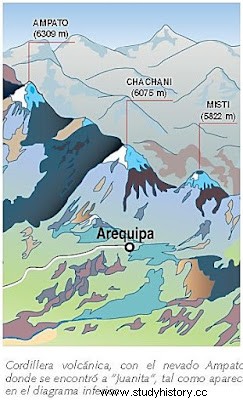 Johan Reinhard, the "gringo", had been doing adventure tourism since he was 15 years old, climbing mountains in the Himalayas (Asia) and in the Andes. He had the "Rolex Risky Investigations" award. In addition, he held the world record for ascents to peaks of more than six thousand meters of altitude. He had diligently studied Machu Picchu, Chavín de Huántar and the Nasca Lines. He was thus familiar with Peruvian nature and the traces of its ancient inhabitants. For him and Miguel Zárate, a guide from Arequipa, it was almost a routine thing to visit the "apus". One day in 1995, when they were climbing Ampato (6,380 m altitude), Miguel Zárate observed a shiny object emerging from a small hollow at the lower limits of the glacier. "Here's something!" he said excitedly. They went down to the place and found a bundle. They cleaned it carefully and, to their amazement, they saw that it was a mummy. Reinhard said it was the best preserved frozen mummy in the world. Also, ...it was from a teenage girl. Zárate baptized her as "Juanita", in homage to Johan (Juanito). In the small sanctuary of "Juanita", they found several "illas" (gold and spondylus statuettes), keros, huacos and camelid skin shoes. For her "food in the afterlife", 19 types of plants were buried around "Juanita", among which corn and various legumes stood out. A few days later, "Juanita" was transferred to the city of Arequipa where she was placed in a refrigerator.
Johan Reinhard, the "gringo", had been doing adventure tourism since he was 15 years old, climbing mountains in the Himalayas (Asia) and in the Andes. He had the "Rolex Risky Investigations" award. In addition, he held the world record for ascents to peaks of more than six thousand meters of altitude. He had diligently studied Machu Picchu, Chavín de Huántar and the Nasca Lines. He was thus familiar with Peruvian nature and the traces of its ancient inhabitants. For him and Miguel Zárate, a guide from Arequipa, it was almost a routine thing to visit the "apus". One day in 1995, when they were climbing Ampato (6,380 m altitude), Miguel Zárate observed a shiny object emerging from a small hollow at the lower limits of the glacier. "Here's something!" he said excitedly. They went down to the place and found a bundle. They cleaned it carefully and, to their amazement, they saw that it was a mummy. Reinhard said it was the best preserved frozen mummy in the world. Also, ...it was from a teenage girl. Zárate baptized her as "Juanita", in homage to Johan (Juanito). In the small sanctuary of "Juanita", they found several "illas" (gold and spondylus statuettes), keros, huacos and camelid skin shoes. For her "food in the afterlife", 19 types of plants were buried around "Juanita", among which corn and various legumes stood out. A few days later, "Juanita" was transferred to the city of Arequipa where she was placed in a refrigerator.The "Lady of Ampato" caused a sensation in the scientific world The discovery of "Juanita", who began to be called also the "Lady of Ampato", caused a sensation in the scientific world. In the months of May and June 1996, "Juanita" was exhibited at the headquarters of the National Geographic Society, in Washington, in a specially heated urn. When Mrs. Hilary Clinton visited her, she made a very funny comment, she said:"... I wish I had my skin as well cared for as the Lady of Ampato's." The National Geographic magazine for the month of June 1996 launched a special insert on "Juanita", with 20 pages, 22 photographs, 3 drawings and 3 infographics. Konrad Spindler stated that:"she is the best preserved human being in the Americas." Reinhard launched an affirmation:"She is the first woman found in the Andes closest to Cusco... she could have been from Cusco, she could have reached the snowy peak alive and could have been sacrificed as a couple."
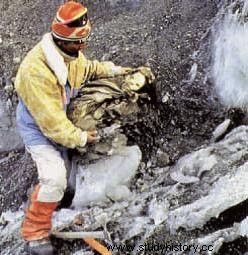 The mummy of “Juanita” is shown by the Arequipa mountaineer Miguel
The mummy of “Juanita” is shown by the Arequipa mountaineer MiguelZárate, on September 8, 1995 (photo:National Geographic). Who had been the “Lady of Ampato”? The "Ice Maiden" ("Ice Lady"), another nickname with which "Juanita" became known, was subjected to a virtual autopsy in the laboratories of the Johns Hopkins Hospital in Baltimore, Maryland-United States. Through a complex computerized system, three-dimensional tomography and X-ray plates were made. Scientists came to the following conclusions:1. "Juanita" died at the age of 14; between 1440 - 1450 AD2. She had not suffered from any illness. 3. she had a size of 1.40 m. 4. "Juanita" was slim and beautiful. 5. She had enjoyed eating a perfectly balanced diet. 6. She had perfect teeth and strong bones. 7. They had prepared her so that she would die sacrificed in honor of the "apu" Ampato, to calm her fury. 8. She had fasted one day before the sacrifice to the god of tremors. 9. "Juanita" had died from a well-aimed blow to the head, produced with a baton, "... like a blow from a baseball bat," when she was kneeling. 10. Scientists found that she had a 0.5m crack in her skull and internal bleeding that ended her short existence.
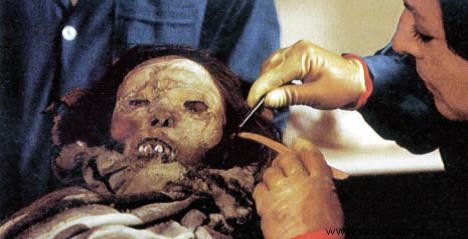 “Juanita” undergoing a rigorous medical-scientific examination The DNA of "juanita" and irrefutable scientific verification Scientists at the Genomic Research Institute (TIGH) in Maryland, in another laboratory test, managed to recover a group of cells extracted from the heart tissues of "Juanita". These scientific tests served to:1. Identify her DNA ("deoxyribonucleic acid"). 2. The DNA of "Juanita" was compared with the Genetic World Map program, prepared by the Human Genome Project. 3. Those studies showed that "Juanita" was closely related to the Ngoge tribe of Panama and to the ancient races originating from Taiwan and Korea. The Human Genome Project, for five years, had mobilized hundreds of biologists who had collected blood samples from all the nations of the Earth, geographically locating the groups of DNAs. That world sample showed that "... the human race It came down from the trees in northeast Africa and spread to all corners of the world."4. The study of the DNA of "Juanita" showed, therefore, that the Asian man who arrived through the Bering Strait to America came from Taiwan and Korea.
“Juanita” undergoing a rigorous medical-scientific examination The DNA of "juanita" and irrefutable scientific verification Scientists at the Genomic Research Institute (TIGH) in Maryland, in another laboratory test, managed to recover a group of cells extracted from the heart tissues of "Juanita". These scientific tests served to:1. Identify her DNA ("deoxyribonucleic acid"). 2. The DNA of "Juanita" was compared with the Genetic World Map program, prepared by the Human Genome Project. 3. Those studies showed that "Juanita" was closely related to the Ngoge tribe of Panama and to the ancient races originating from Taiwan and Korea. The Human Genome Project, for five years, had mobilized hundreds of biologists who had collected blood samples from all the nations of the Earth, geographically locating the groups of DNAs. That world sample showed that "... the human race It came down from the trees in northeast Africa and spread to all corners of the world."4. The study of the DNA of "Juanita" showed, therefore, that the Asian man who arrived through the Bering Strait to America came from Taiwan and Korea.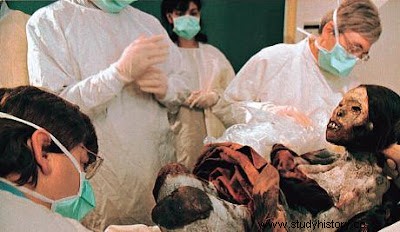 Group of American doctors examining the mummy “Juanita”
Group of American doctors examining the mummy “Juanita”(photo :National Geographic). The testimonial presence from "Juanita" "Juanita" is found in the Museo Santuario de Altura del Sur Andino, of the Catholic University of Santa María de Arequipa. This museum is located at 305 Samuel Velarde Street, Umacollo-Arequipa. "Juanita" is in a special freezer, protected from the environment by a glass chamber, sealed under vacuum. The urn is secured with steel profiles and has two more layers of Plexiglas inside. The internal environment of "Juanita's" chamber is regulated by a computerized freezing system that maintains a temperature between -19.2 and -19.5º Celsius, so that the mummy does not dehydrate. Next to her are the "Urpicha" ("dove"), a mummy found in Pichu Pichu (5600 m altitude), Arequipa; "Sarita", found in the Sarasara, between Arequipa and Ayacucho; and five other mummies found in the Misti snow-capped mountain in August 1998. These findings of adolescents sacrificed in honor of the "apus" show that human sacrifices were also practiced during the Inca times.
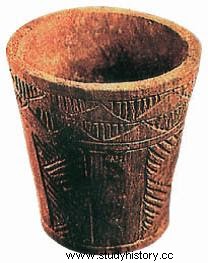 Carved wooden vessel found among
Carved wooden vessel found among utensils in the tomb of Juanita The Inca mummies of Llullaillaco (Argentina) As if to ratify what it means to have found "Juanita", an expedition of the National Geographic Society explored the peaks of the snowy Llullaillaco, Argentina between March 16 and April 6, 1999, and found three mummies that had an age of 500 years. This historical discovery was widely commented, and confirmed two facts:1. The Tahuantinsuyu extended their domains to the southeast to the current Republic of Argentina, and 2. It was confirmed that human sacrifices were made in the time of the Incas. According to the Efe agency, they were almost 7,000 meters high in an Argentine volcano, on Mount Llullaillaco, and will allow a deeper understanding of the type of sacrifices that the Incas offered to their gods. known, covered with rich clothes and surrounded by offerings and gold statuettes, the mummies have resisted the passage of time, protected by the low temperatures that prevail in the Andean foothills... More than 500 years after two girls and a boy were sacrificed as an offering to the gods by that civilization, their bodies have been recovered in an excavation led by archaeologist Johan Reinhard, under the auspices of the Nationa l Geographic, which has promoted archaeological excavations under the oceans, the polar ice caps and the ancient civilizations of the world”.
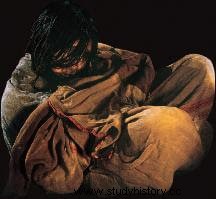 One of the three mummies found in Llullaillaco, in perfect condition The offerings found in the Llullaillaco “The smallest bundle of a girl around eight years old is the one that made the biggest impression. Her dark face, the only thing visible at the moment, is perfectly preserved and you can even see her half-open eyes, in addition to her black hair with a mascapaycha (a rusty gold plate of more than 10 centimeters that looks like a fungus). . She is wrapped in a covering of wool blankets of different shades of brown, made of alpaca wool, in which there are some traces of burns as a possible consequence of a lightning strike. The other two relics belong to a fourteen-year-old girl and a boy between the ages of eight and nine. None of them is identified by a specific name so far. These bodies were found with 36 gold, silver and spondylus valve statuettes, cloaks, fabrics with brightly colored geometric decoration, feather headdresses, chuspas (woven bags) with charqui food, broad beans and coca leaves. In addition, an aríbalo (very fine ceramic vessel), leather sandals with wool straps, a headband, a kind of wool rope, a llama figure and a wooden spoon were found. There were also seashell necklaces (spondylus), which came from the Pacific Ocean and signify dominion over the waters (“El Comercio”; 03-15-99). Currently, these mummies are found in Salta, 480 km from the Pacific Ocean. find, where they were taken with the bodies still frozen, in special containers. The mummies are found at the University of Salta, at 15 degrees below zero, a temperature close to that of the summit of the Llullaillaco volcano.
One of the three mummies found in Llullaillaco, in perfect condition The offerings found in the Llullaillaco “The smallest bundle of a girl around eight years old is the one that made the biggest impression. Her dark face, the only thing visible at the moment, is perfectly preserved and you can even see her half-open eyes, in addition to her black hair with a mascapaycha (a rusty gold plate of more than 10 centimeters that looks like a fungus). . She is wrapped in a covering of wool blankets of different shades of brown, made of alpaca wool, in which there are some traces of burns as a possible consequence of a lightning strike. The other two relics belong to a fourteen-year-old girl and a boy between the ages of eight and nine. None of them is identified by a specific name so far. These bodies were found with 36 gold, silver and spondylus valve statuettes, cloaks, fabrics with brightly colored geometric decoration, feather headdresses, chuspas (woven bags) with charqui food, broad beans and coca leaves. In addition, an aríbalo (very fine ceramic vessel), leather sandals with wool straps, a headband, a kind of wool rope, a llama figure and a wooden spoon were found. There were also seashell necklaces (spondylus), which came from the Pacific Ocean and signify dominion over the waters (“El Comercio”; 03-15-99). Currently, these mummies are found in Salta, 480 km from the Pacific Ocean. find, where they were taken with the bodies still frozen, in special containers. The mummies are found at the University of Salta, at 15 degrees below zero, a temperature close to that of the summit of the Llullaillaco volcano.JULIO VILLANUEVA SOTOMAYOR "Biographies" - JUANITA
